In this blog post, I’m going to tell you a little about my Behcet’s story and what it’s been like living with the disease for the past 25 years.
Now keep in mind, this is my story. While all Behcet’s sufferers share the same diagnosis, we don’t all share the same symptoms, severity, and prognosis. There’s a lot of variability from one Behcet’s patient to the next.
So don’t let any part of my story discourage you. Your story will, in all likelihood, be quite different. Just because I went through this horrible thing or that horrible thing doesn’t mean you necessarily will.
I should also mention that this is a highly abridged version of my story. Though I’ve included most of the serious symptoms I experienced over the years, there are lots of less-serious ones I left out. This is just a brief, 2,000-word summary.
Now with that little disclaimer out of the way: it’s story time.
Pre-Diagnosis
Table of Contents
The year was 1997. On a warm late-June night, after hours of watching MTV (which still played some music back then), chain-smoking Marlboro Reds out my basement-bedroom window, and reading one of the dirty magazines I kept stashed under my bed, sixteen-year-old me dozed off to sleep. It was a perfectly normal night and nothing seemed out of the ordinary.
But the following morning was anything but normal. When I woke up, my left eye felt like a wasp had flown in there and was trying to sting its way into my brain. There’s sharp pain and then there’s sharp pain. This was more intense than anything I’d ever experienced – and that’s saying something.
Almost a decade earlier, I ran into a wasps nest while playing outside. My mother, a registered nurse, counted more than 20 sting all over my body. Don’t get me wrong: that totally sucked. But the pain in my left eye on that Saturday morning in ’97 hurt more than 100 wasp stings.
But the pain in my eye wasn’t what worried me the most. It was the fact that I couldn’t see. Literally overnight, I lost vision in my left eye. When I’d gone to bed the night before, my vision seemed fine. I certainly didn’t notice any problems while reading Barely Legal or watching Beavis and Butthead.

13-year-old me in my Rage Against The Machine tee shirt.
This is one of the scariest aspects of having Behcet’s: how quickly things can go from just fine to catastrophic.
I told my mother about my eye and she brought me to see a nearby ophthalmologist. It was a Saturday morning and he made no attempt to hide how much he resented having to come in on his day off.
He also made no attempt to hide how serious the inflammation in my retina was. “I’ve never seen anything like it,” the doctor told me. Not exactly something a scared teen wants to hear from a medical professional. Little did I know it would be the first time of many that I’d hear some variation of that phrase come out of a doctor’s mouth.
The ophthalmologist said he’d never seen such severe inflammation come on so quickly before. He also told me he didn’t know what had caused it. So he referred me to a retina specialist in Boston who I went to see the following week.
While the cause of my inflamed eye was mysterious, it was hardly the first strange, painful, unexplained thing to happen to me. Just weeks earlier, over the course of a few days my right knee swelled up to the size of a grapefruit – a very large grapefruit – and required arthroscopic surgery. Like the ophthalmologist, the surgeon had no idea what had caused the inflammation in my knee.
But the weirdness didn’t start with my knee. For years I’d been getting strange bumps, humps, and lumps all over my body. Sometimes my joints would hurt for days or even weeks, only to eventually return to normal.
And then there were the sores I’d get in the two last places you’d ever want them: in my mouth and on my balls. They began in middle school, getting more frequent and more severe as time went on.
Not only did the on-call ophthalmologist and the surgeon have no clue what was causing my strange symptoms. Neither did a dermatologist I’d seen, my pediatrician, or either of my parents – both accomplished nurses.
But the retina specialist in Boston I was referred to did.
Diagnosed
After years of strange symptoms and a string of baffled healthcare professionals, I met a doctor who finally gave me the name of what had been wreaking havoc on my body for years: Behcet’s disease.
The highly-trained retina specialist at the Massachusetts Eye and Ear Infirmary in Beantown put the puzzle pieces together: the retinitis, oral and genital ulcers, joint pain, skin problems, and other unexplained symptoms and confidently diagnosed me with Behcet’s, a rare autoimmune disease.
The doctor himself was rude, arrogant, and impatient – but I didn’t care. I was just happy to finally know what was wrong with me so it could be cured and I could move on with my life.
Too bad there was no cure for Behcet’s disease in 1997 and there still isn’t today.
 The retinologist referred me to a rheumatologist, a doctor who specializes in diseases like Behcet’s. He put me on a cocktail of drugs including prednisone, methotrexate, colchicine, folic acid, and Vicodin for the painful ulcers.
The retinologist referred me to a rheumatologist, a doctor who specializes in diseases like Behcet’s. He put me on a cocktail of drugs including prednisone, methotrexate, colchicine, folic acid, and Vicodin for the painful ulcers.
Unfortunately, it wasn’t enough to keep the Behcet’s at bay. The ulcers continued. If anything, they got worse. And then about seven months after the uveitis in my left eye, I started experiencing pain and stiffness in my left leg.
Stiffness and pain were nothing unusual. I’d experienced both all over my body for years. They’d come on gradually over a few days, then go away over a few more. But my right leg kept getting worse and worse until the pain was unbearable and I couldn’t bend it at all.
Of course, this was on a weekend. I couldn’t get in to see my pediatrician or rheumatologist and had no choice but to go the the emergency room. They promptly admitted me to the hospital.
I spent the better part of a week there as the doctors tried to figure out what was wrong with me. They suspected one or more blood clots, but an ultrasound didn’t find any and neither did the other tests they ran.
But then magnetic resonance imaging (MRI) – still a relatively new technology at the time and a very expensive one – revealed clots in the deep veins of my left leg and in my inferior vena cava, a vein that carries deoxygenated blood to the heart. After a long, frustrating week, I finally left the hospital with a prescription for the anticoagulant (blood thinner) Coumadin and a referral to a hematologist (blood specialist).
Over the next few months, my leg mostly returned to normal and I was able to come off the anticoagulant. Though no one else besides my rheumatologist and I seemed to notice the difference, my left calf was still ever so slightly larger than the right. It would stay that way for well over a decade.
The oral and genital ulcers, in addition to a variety of other embarrassing often painful skin problems, persisted into my twenties. Fortunately, I didn’t have any more problems with my eyes, nor did I get any more blood clots during those years.
Behcet's Disease Uncensored (BDU) is a podcast to discuss this rare illness.
Behcet's doesn't censor itself when it attacks our bodies. So why should we censor ourselves when discussing it?
Listen to BDU on Spotify or wherever you listen to podcasts.
A Nice (but too short) Break
 By the time I was in my mid-to-late twenties, the ulcers, skin problems, and joint pain more-or-less went away completely. I gradually tapered off all the meds I’d been on, including the opioid analgesics I’d been prescribed for nearly a decade.
By the time I was in my mid-to-late twenties, the ulcers, skin problems, and joint pain more-or-less went away completely. I gradually tapered off all the meds I’d been on, including the opioid analgesics I’d been prescribed for nearly a decade.
When I turned thirty in 2010, I finally reached something I’d thought would never be more than a dream: remission. Remission is when the severity of an illness is greatly reduced or it stops altogether.
I’d read that, for a lot of people diagnosed with Behcet’s, it often hits hard for a few years and then goes into full remission. For a lucky few, the disease never seems to return.
But I’m not that lucky.
Clots – Round 2

During my remission years, I went extra hard in the gym.
In 2015, after more than five years of remission, Behcet’s decided to come out and play again. Just like the pain and stiffness in my left leg nearly twenty-years earlier, I experienced the same thing in my right.
I really didn’t want to go back on medication. I didn’t even want to see a doctor. It had been about five years since I’d even stepped foot in a doctor’s office. But the pain got so bad I eventually had no choice.
I ended up getting admitted to the same hospital I was at with the clots in 1998. Fortunately, this time I only had to stay for one night. An ultrasound revealed massive clots in not just might right leg, which was the only stiff and swollen one: I also had massive clots – though less severe – In my left.
And just like that I was back on meds and back to seeing several doctors. I went back to the rheumatologist I’d seen in my teens and twenties and he started me on azathioprine in addition to the blood thinner the hospital had already put me on.
It seemed to work. My legs gradually got better and I eventually came off the Coumadin. For the next couple years, no new symptoms.
3rd (and hopefully final) Round of Clots
But then in 2018, more pain and stiffness in my legs. An ultrasound revealed more clots.

In spite of having Behcet’s, I’ve lived an awesome life.
The clots in my legs – medically known as deep vein thromboses or DVTs for short – aren’t usually much of a danger themselves. But if one of those clots break off and travel to the lungs, big trouble: pulmonary embolism or PE.
Since I’d had not one, not two, but three series of clots spanning two decades, my doctors and I discussed permanently staying on a blood thinner. Warfarin sodium, which is the generic name for Coumadin, requires frequent blood work. Those of you who’ve been on it know what a pain in the ass this can be.
Fortunately, some newer anticoagulants have come on the market in recent years that don’t require any blood work. My doctor suggested one called Eliquis (apixaban) and after looking into it decided to give it a try.
I’ve been on Eliquis since the spring of 2018 and since then, no new clots. I like it a million-times more than Coumadin. And I’m also staying on azathioprine and a couple other medications indefinitely. As much as I wish I didn’t need any meds, I’ve come to accept that it’s probably best if I stay on them for life.
Since the 2018 clots, I haven’t had any major Behcet’s symptoms. Just the occasional skin oddity, but usually nothing requiring a trip to the doctor.
There’s A Lot More To The Story
 And that just about sums up my Behcet’s story. But it is just a summary. There’s still a lot I left out. This has just been a short and sweet version of a much-longer and much-less-sweet story about living with Behcet’s for the past 25 years.
And that just about sums up my Behcet’s story. But it is just a summary. There’s still a lot I left out. This has just been a short and sweet version of a much-longer and much-less-sweet story about living with Behcet’s for the past 25 years.
If you’re interested in hearing my full Behcet’s story, you can read every last dirty, dark detail in the book I wrote about living with the illness. It’s called Finding Happiness Through Pain and Embarrassment: My Life With Behcet’s Disease – A Memoir.
It’s available in both print and ebook format everywhere books are sold. An audiobook version is in the works and will be available soon. To be among the first to know when it comes out, make sure to subscribe to the Ellis Michaels mailing list below if you haven’t already.
Join the Ellis Michaels mailing list to get notified about new Behcet's disease articles and publications, up-to-date news and info about this rare illness, and more.
I Want To Hear Your Story
Now that you know a little about my Behcet’s story, I’d love to hear a little about yours. Feel free to tell as much or as little as you’d like in the Comments section at the bottom.
You might also be interested in some of my other Behcet’s-related blog posts:



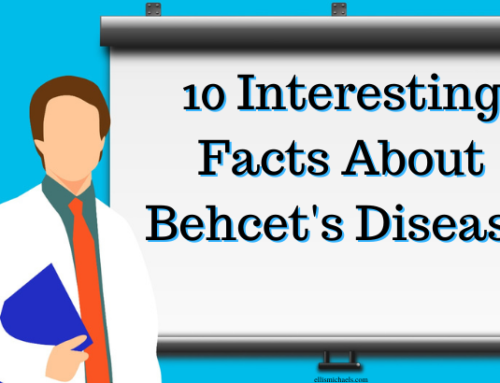
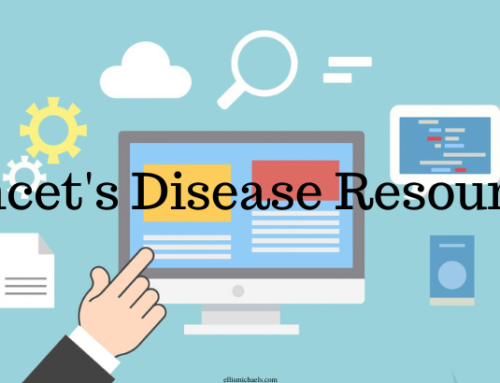
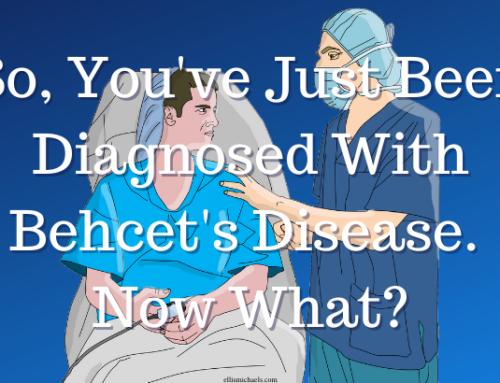
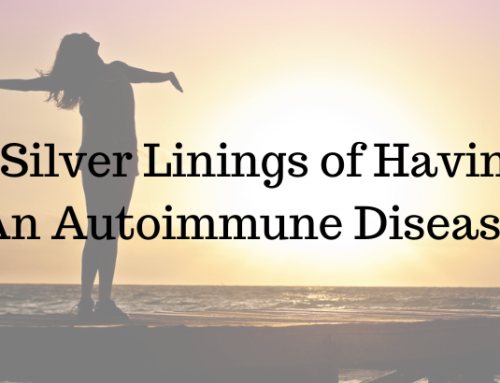
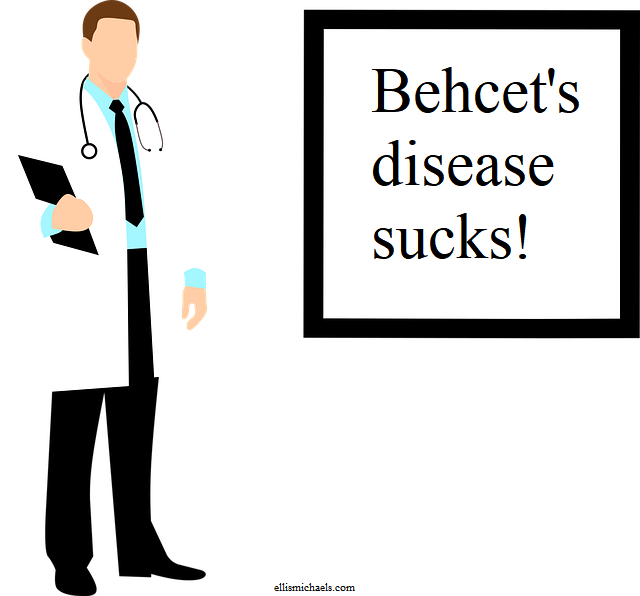
Leave a Reply